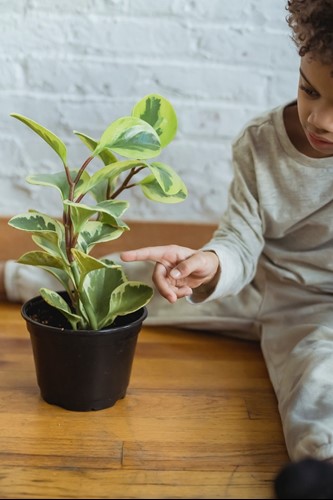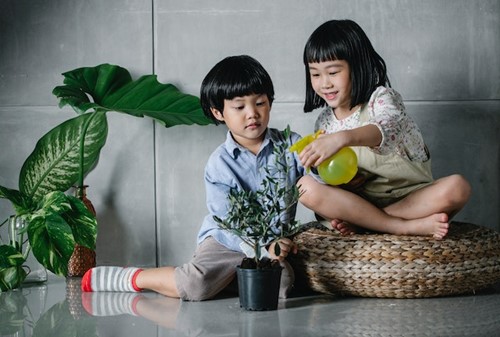Safe Houseplants for Kids
Plant safety is not a topic that immediately springs out when you initially consider getting a new houseplant as the focal point of your room. You may even be unaware that a number of traditional house plants can, in fact, be toxic as.In general though, any hazards they might present are usually irrelevant to your use case.

However, where children are involved, the hazards can become real, as if they place a leaf in their mouths or overly handle what they consider a beautiful flower can suddenly present dangers.
Knowing the distinction between having the safety of different types of calathea in your home as opposed to having a Peace Lily or golden pothos, both of which present dangers, can help with your peace of mind.
Not All Plants Are Safe for Kids
While plants are beautiful, they are not necessarily benign. Very common house plants can cause severe illness if certain parts of it are ingested, and others can cause irritation and other issues if touched. Although, for adults, any issues are going to be pretty redundant, for young children with inquiring minds it can be quite worrisome.
Everyday houseplants that you are unlikely to have even considered hazardous can be especially problematic. Plants, such as the Philodendron, Aloe Vera, and the Porthos plant, can be extremely dangerous as they contain calcium oxalate raphides, sometimes referred to as raphides for short. This chemical substance is poisonous and can also result in skin reactions such as rashes and even possibly breathing problems for those with a severe allergic reaction.
Precautions That Can Be Taken to Avoid Problems
One answer is to destroy or just get rid of plants that have the potential to be toxic. However, with careful thought and placement, you can still enjoy these plants and eliminate possible risks to your children.
If you are going to put a plant in a young child's bedroom, then it needs to be from a safe list as regular close contact with a potentially toxic houseplant can lead to temptation. A child's allergies are also likely to be considerably impactful. Knowing what pollens and from which plants specifically affect them will help with your decisions.
Beyond controlling the variety of any plant in a child's room or play area, in the general run of the house you should look to place the plants well out of a child's reach. Place them high up on shelving or a mantle rather than low down on coffee or dining tables.
Why You Shouldn't Eliminate Plants
While we talk of possible dangers some plants potentially possess, it is also essential that your child grows up in an environment that brings them as close to the wonders of nature as you can.
Plants perform many functions besides just being design features or focal points in your room. They also have considerable health advantages for everyone, including your children. These include air purification, removing carbon dioxide and increasing oxygen levels, helping humidity control, and help for your mental well-being.
With so many positive benefits, keeping plants is actually necessary to the wider family and the environmental health of your home. Indeed, you should consider plants an essential component of your living space's ecosystem.

Houseplants That Are Safe For Kids
It is a question of balance, playing off potential risks against the massive benefits houseplants also possess. Getting the right mixture of plants in the right places in your home might require a little planning but can pay dividends offering all the advantages without the drawbacks for your child.
Using plants that are child friendly will be the best solution for new plant additions or replacements for plants that you are worried about. The good news is that there are a whole plethora of beautiful plants that you can substitute in, so that you can continue that green vibe running through your home.
How Do You Identify Plants that Are Safe for Children?
Knowing that you should incorporate child-safe plants into your living space is one thing; being able to identify them is more problematic. However, if you have a set process of checks, picking out child-safe plants is not too difficult.
If you consider the following guidelines when looking to add to your plant collection, you should be good to go. These include buying your plants from suitable establishments, doing proper research, avoiding wild plants you might see on tour travels, and being cautious of asking or accepting a neighbour's cuttings.
Where to Avoid Buying or Getting Plants From
It is probably best to first look at where you shouldn't go for your new plant purchases. Plants are available practically everywhere. You will often see a row of beautiful plants for sale sitting outside your local gas station, or you may see them in your nearest big box store.
Information that is available for these plants is often sparse, generally left to just an obscure label, if there even is one, and if it is correct or has the details on toxicity needed. In addition, the cashier or pump attendant is likely to know as much about plants as they do about quantum computing.
Using a Reputable Nursery to Buy Your Plants
A reputable local plant nursery is the perfect place to travel for the right plant if you want to be as sure as you can about your plant purchases.
At a nursery, you are going to encounter knowledgeable staff that can help guide you toward the safest houseplants for kids. Generally, this might end up with the prospective plants being higher priced than elsewhere. Where potential hazards to your child could exist, this should be an insignificant concern.
Doing Your Research
It always pays to know how to research a plant you see. While it doesn't actually replace expert knowledge, if you are stuck or determined to find a plant you like at a better value, then this is a valuable skill to be able to call on.
If you are fairly sure that a plant labelling is correct then it is not too difficult to employ the use of your smartphone to help you out. If you go to the right horticultural site, then you are likely to find far more detailed information, including toxicity and potential allergy problems, than the labelling can ever provide.
The trick is to pre-research the best and most authoritative horticultural websites and have them saved to your favourites so that the information is available when needed.
Avoiding Wild Plants and Cuttings
Unless you are incredibly confident about your ability to identify a plant correctly, then it is probably best that you avoid taking cuttings from wild plants that you might see adorning the side of the road, in a park, or just randomly growing on the landscape.
Yes, there are apps on your phone that you can use to photo-identify a plant that catches your eye. However, these apps predominantly work off user-supplied information that may or may not be correct, which leads to inconsistent identification in the results of different applications.
Conclusion
Houseplants are a standard feature of almost all living spaces, and having a diverse variety of types helps both interest and health in your property. However, potential dangers that might be posed to children should never be discounted. It only takes a young child to chew on the leaf of the wrong plant for a possible trip to the emergency room to ensue.
There is much that you can do to enjoy the best advantages of plants and still maintain child safety. From positioning, to research to only purchasing safe houseplants for kids, you can still enjoy the benefits of green surroundings.